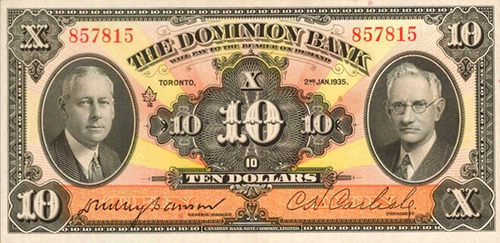After the revolution
Movie money
The remainder Estado de Sonora were the most common notes used by Hollywood as movie money. In 1968 a warehouse crammed with remainders was discovered in Sonora during the filming of the Warner Bros. movie ‘The Wild Bunch’. The hoard was sold to film studios and coin dealers at 25c on the peso. Although most of these were absorbed into the numismatic market, some of them turned up in the film 'Bonnie and Clyde'Philip Reisman Jr., "Mexican Stand-In", in Bank Note Reporter, March 1982).
Curios
Some of these notes were also secured by curio stores and for quite a number of years they sold them at five cents each. One store-owner said that it was surprising the number of people that bought these notes for their bill folders, so that they could make a fine show of their currency, and make other believe they had more money than was the case. However, by 1939, when a ABNC employee tried to secure a set of notes, he was surprised to find that several of these curio stores no longer had them, as the United States Secret Service operators had called and confiscated their stocks, advising them that the reason was because Mexican people were being stung by tricksters who were passing these notes as genuine currency. However, he was able to secure a set of five different denominations and the dealer, who was skipped by the Secret Service men, told him that the demand for these notes was now so great that he had doubled his price to ten centsABNC, folder 470, Estado de Sonora (1938-1940), letter D. A. Moir to ABNC, 29 March 1939.
Use in scams
In the 1930s the United States Secret Service became interested in the possibility that Estado de Sonora remainders could be used in scams. On 10 April 1936 a representative of theirs called on Mr. Schomp at the American Bank Note Company with respect to a $5 note which had come into their possession. He said that a good many of these notes had been found to be in circulation in the States, and while there was no law prohibiting their existence, it was only natural that the government would prefer to have the notes taken out of circulation entirely. Unless it was possible to find someone that was actually trying to pass the notes as legal tender or selling them to the public with fraudulent intent, there was little chance of doing much about it in the States. Therefore the ABNC wrote to its resident agent in Mexico City, Charles T. Blackmore, asking whether there was anything that the Mexican government or the Banco de México could doABNC, folder 470, Estado de Sonora (1914-1936). Blackmore reported that the present Mexican government had no knowledge of the Sonora issue, and though the Secretario de Crédito Público ordered a thorough investigation nothing was doneibid..
In late September 1937 a $10 Estado de Sonora note (Series E, 2559) was received by the Manufacturers National Bank of Detroit in a package of Canadian money and the bank asked the American Bank Note Company whether it was genuine. The bank had in fact received several of these notes and complained about the similarity of design with the $10 notes printed by the Canadian Bank Note Company for the Dominion Bank, stating that it was very easy to accept this note as a Canadian banknote when it was accompanied by $10 Dominion Bank notesABNC, folder 470, Estado de Sonora (1938-1940) letter, B. F. Marsden, ANBC, Detroit to ABNC, New York, 25 September 1937 .

1935 $10 note of the Dominion Bank
Four days later the Detroit Bank warned the ABNC that $1, $5 and $10 Estado de Sonora notes were being circulated in the district and on account of the similarity, being passed on merchants as Canadian moneyABNC, folder 470, Estado de Sonora (1938-1940) letter, A. H. Hupp, Detroit Bank to ABNC, New York, 29 September 1937 .
